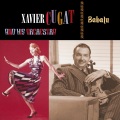
Babalu
Anyone looking for the very best in Latin-American dance music will surely turn to Xavier Cugat. Born on the first day of the 20th century in the Catalan city of Gerona, Spain, his family moved to Cuba when he was three and settled in Havana. He was given his first violin at the age of six, and began studies at the Peyrellade Conservatory. At twelve Xavier became first violin in the Havana National Theatre Symphony Orchestra, and under the direction of Tulio Serafin he also began a period of opera, playing in the orchestra during a season of concerts given by the great Italian tenor Enrico Caruso. (Xavier drew a caricature of Caruso which delighted the great man, himself also a sketcher and caricaturist, and that incident became the starting point of their friendship). Caruso insisted that the young Cugat should come to New York to play, to improve his technique, assuring him that he would introduce him to the right people and encourage the young Catalan in his musical career. Still only twelve, Xavier made the journey alone to New York. There he enrolled at the Frank Damrosch school where Franz Khiesel was his teacher; then, at the insistence once more of Caruso, he went on to continue his studies in Berlin, also playing concerts with the Berlin Symphony Orchestra. And when Caruso needed a talented violinist to play between his recitals he hired the young Cugat, and they toured together. However, concert work was not plentiful, so he took himself off to California, where the enterprising Xavier found work as a cartoonist for the Los Angeles Times newspaper, and worked as music composer for a motion picture studio. By now, the American entertainment world greatly attracted Cugat and in the late 1920s he formed his own orchestra, specializing in Spanish and Latin-American music, opening at the Coconut Grove in Los Angeles. He certainly helped spread the popularity of the rhumba, the tango and the conga, plus all those intricate Spanish rhythms that add so much colour. The thirties found him back again in New York playing violin in the band of Phil Harris, when he was hired to lead the relief band at the Waldorf Astoria Hotel in the heart of New York City, a place where he was later to star on many occasions over a period of fifteen years, from 1932 until 1947. With his great natural sense of showmanship, the band’s flaming red jackets and his ever-present smiling countenance, ‘Cugie’ presented his music to the American public for dinner and supper dancing in the most captivating manner. And later in the thirties, 1934-35, Cugat’s was one of the three bands on the historic coast-to-coast ‘Let’s Dance’ radio show, where he was proclaimed ‘The Rhumba-Tango King.’ It was during the 1940s that Xavier Cugat & His Orchestra probably achieved its greatest popularity, not least because of Miguelito Valdés, the foremost singer of Afro-Cuban melodies. The recording of Babalu by Valdés with the Cugat orchestra brought both the most enormous fame. When Valdés finally decided to leave Cugat, the young Tito Rodriguez came in as singer-percussionist, but didn’t stay long. Another Cuban who recorded with Xavier Cugat during that era was the great Machito, in 1941, although he never actually worked regularly with the band. Cugat and his orchestra also made appearances in numerous Hollywood movies, such was his great popularity, for there was no doubt that he was a master showman, with that true Latin flavour, as well as being a man of great personal charm and wit. He was equally well known for his attraction for lovely ladies, five of whom became wives. Perhaps less known is that he was a brilliant cartoonist, one of the three great passions of his life, according to his own words. (Music was another and it needs little imagination to guess the third.) But there is no doubt that no other Latin band leader ever achieved the popularity, or captured the imagination of the public, as much as Xavier ‘Cugie’ Cugat.
专辑歌曲列表
-
xavier cugat 2807569 02:55
-
xavier cugat 2971733 03:05
-
xavier cugat 2916357 03:02
-
xavier cugat 2874137 02:59
-
xavier cugat 3202673 03:20
-
xavier cugat 2609363 02:43
-
xavier cugat 2563805 02:40
-
xavier cugat 3000991 03:07
-
xavier cugat 2725757 02:50
-
xavier cugat 2715942 02:49
-
xavier cugat 2771309 02:53
-
xavier cugat 3213202 03:20

